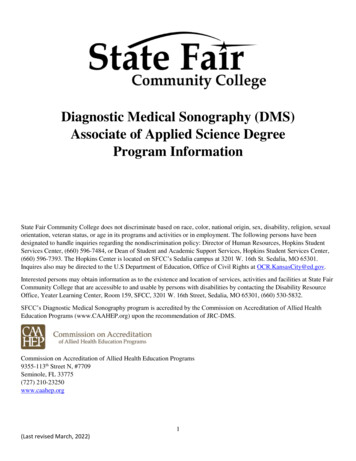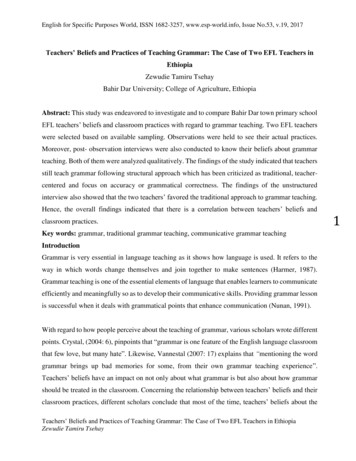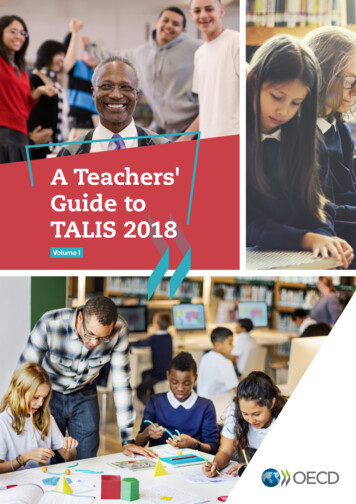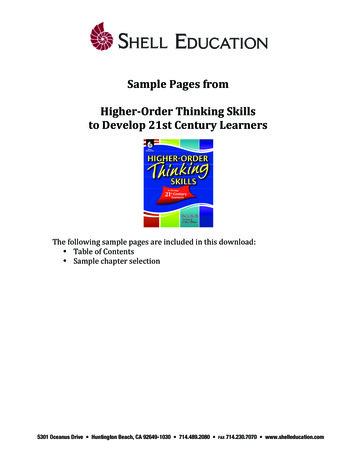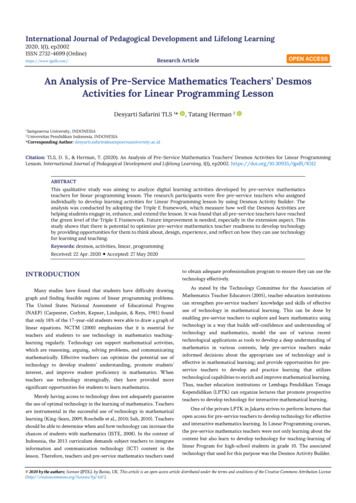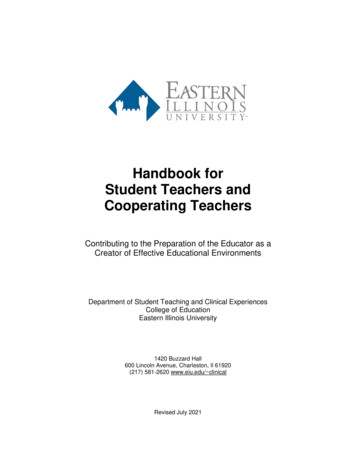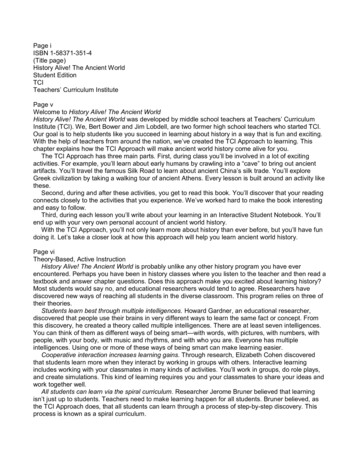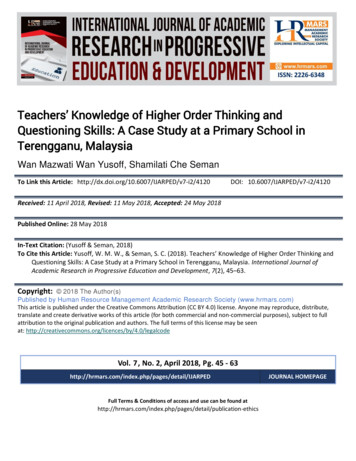
Transcription
Teachers’ Knowledge of Higher Order Thinking andQuestioning Skills: A Case Study at a Primary School inTerengganu, MalaysiaWan Mazwati Wan Yusoff, Shamilati Che SemanTo Link this Article: http://dx.doi.org/10.6007/IJARPED/v7-i2/4120DOI: 10.6007/IJARPED/v7-i2/4120Received: 11 April 2018, Revised: 11 May 2018, Accepted: 24 May 2018Published Online: 28 May 2018In-Text Citation: (Yusoff & Seman, 2018)To Cite this Article: Yusoff, W. M. W., & Seman, S. C. (2018). Teachers’ Knowledge of Higher Order Thinking andQuestioning Skills: A Case Study at a Primary School in Terengganu, Malaysia. International Journal ofAcademic Research in Progressive Education and Development, 7(2), 45–63.Copyright: 2018 The Author(s)Published by Human Resource Management Academic Research Society (www.hrmars.com)This article is published under the Creative Commons Attribution (CC BY 4.0) license. Anyone may reproduce, distribute,translate and create derivative works of this article (for both commercial and non-commercial purposes), subject to fullattribution to the original publication and authors. The full terms of this license may be seenat: deVol. 7, No. 2, April 2018, Pg. 45 - Full Terms & Conditions of access and use can be found tion-ethicsJOURNAL HOMEPAGE
International Journal of Academic Research in Progressive Education andDevelopmentVol. 7 , No. 2, April 2018, E-ISSN: 2 22 6 -6348 2018 HRMARSTeachers’ Knowledge of Higher Order Thinking andQuestioning Skills: A Case Study at a PrimarySchool in Terengganu, MalaysiaWan Mazwati Wan YusoffDepartment of Fundamental and Inter-Disciplinary Studies, Kulliyyah of Islamic RevealedKnowledge and Human Sciences, International Islamic University Malaysia, 53100 KualaLumpur, Malaysia. Email: wanmazwati@iium.edu.myShamilati Che SemanSekolah Kebangsaan Gong Badak, Kuala Nerus, 21300 Terengganu, Malaysia.AbstractThe purpose of this research was to explore primary school teachers’ knowledge of higher orderthinking (HOTS) and questioning skills. This was done because little is known about the level ofteachers’ knowledge and skills in HOTS; and their knowledge and skills in questioning to stimulateHOTS. To this end this paper employed exploratory case study to gain an in-depth understandingof this phenomenon in the actual setting so that the actual behaviour can be examined withminimum interference that may obstruct the reality. Nine primary school teachers were selectedto be interviewed and observed. Semi-structured interview questions were used to collect dataon teachers understanding of the concept of thinking and higher order thinking skills; and Likerttype checklist was used to gather data on the frequencies and types of questions teachers usuallyasked to promote thinking. Observations were conducted to validate the teachers’ responsesregarding the frequencies and types of questions asked during teaching and learning sessions.The data gathered through interviews were analysed to determine the emerging themes. Thefindings revealed that the teachers failed to explain clearly the concept of thinking and thinkingprocesses; and majority of teachers could not give satisfactory explanation of HOTS as critical andcreative thinking. However, half of the teachers could list the subskills of HOTS according toBloom’s Taxonomy. Data on teachers’ questioning skills revealed that they were familiar withquestioning based on Bloom’s Taxonomy, however only half of the teachers practised askingHOTS questions based on Bloom’s Taxonomy.46
International Journal of Academic Research in Progressive Education andDevelopmentVol. 7 , No. 2, April 2018, E-ISSN: 2 22 6 -6348 2018 HRMARSKeywords: Higher Order Thinking Skills, Teaching For Hots, Critical Thinking, Creative Thinking,Questioning SkillsIntroductionThe Malaysian Ministry of Education (MOE, 2013) has published a very disheartening resultthat 60% of 15-year-old Malaysian students who had completed lower secondary school failedto achieve minimum proficiency level in thinking skills of knowing, applying, reasoning and intransferring knowledge and skilled learned in classrooms for application in the real-world. MOEfurther reported that compared to 15-year-old students from Singapore, Hong Kong, South Koreaand Shanghai, Malaysia’s 15-year-olds were three or more years behind in schooling. Taking intoaccount this discouraging result, MOE has emphasized achievement in thinking skills as one ofthe aims of strategic planning stated in the Malaysia Education Blueprint 2013-2025. TheBlueprint states: “Every child will master a range of important cognitive skills, including criticalthinking, reasoning, creative thinking, and innovation” (MOE, 2013: E-7).To realize the noble aim of producing students who are skilful in higher order thinking, MOEhas planned and implemented various reformation in curriculum and innovation in teaching andlearning. However, Mohd Azhar, Mohd Koharuddin and Muhamed Fauzi (2006) and Zulkarami(2011) claimed that efforts done by the Ministry of Education were far from reaching the targets.Furthermore, they reported that they did not discover any definite indicator to prove that theculture of HOTS and innovation existed even at a minimal level. Even though the Ministry hasproduced detailed documents of curriculum and syllabus with state of the art teaching andlearning methods and activities, but the most important factor influencing students’ achievementin HOTS is the quality of teachers. Teacher makes or breaks the curriculum.Ministry of Education has made substantial investment in training teachers to teach forHOTS; and it is compulsory for every teacher to know and understand HOTS correctly and clearly(MOE, 2103). However, studies revealed that teachers had only basic knowledge on Bloom’staxonomy of cognitive processes; and they did not understand the functions and the differencesbetween stages of lower order thinking skills and higher order thinking skills. Furthermore,teachers lack knowledge and understanding in methods of teaching for thinking (Abdul Halim &Siti Muhibah, 2015). The same research also found that teachers were unsuccessful in choosingthe appropriate techniques, methods and approaches of teaching for HOTS effectively. What ismore, majority of teachers did not know how to teach for HOTS and some teachers werereluctant to do so (Najeemah, 2007; Yee, Razali, Mimi, Widad, & Tee, 2013); and majority of themhad low self-efficacy in teaching for HOTS (Rosnani & Suhailah, 2003). Another study discoveredthat teachers’ understanding of thinking processes was negligible; and their skills in HOTS werelow, but they displayed high interest in HOTS and teaching for HOTS (Rosma, Ong, Shakinaz, &Wong, 2012).Even though many teachers lacked knowledge and skills in HOTS, but they had positiveperceptions about HOTS and they were confident that teaching for HOTS could enhance students’cognitive abilities (Siti Marlina, 2013). It is shocking, however, to discover that there were stillteachers who were not trained in teaching for HOTS yet (Abdul Halim et al., 2015) even though47
International Journal of Academic Research in Progressive Education andDevelopmentVol. 7 , No. 2, April 2018, E-ISSN: 2 22 6 -6348 2018 HRMARSMOE had instructed teachers to explicitly teach for HOTS since 1989 (MOE, 2013). Recent studiesconducted by Nooriza and Effandi (2015) also discovered that teachers had only minimalunderstanding on the concept of HOTS and they were not well prepared to teach for HOTS.Another study corroborated the findings of Nooriza and Effandi. Mohd Nazri et al. (2017) foundthat teachers had no adequate knowledge on HOTS and how to teach for HOTS. Teachers werenot competent in HOTS and in teaching for HOTS.However, studies conducted by Nor Hamaliza and Zamri (2016) found that teachers wereknowledgeable in HOTS and they had mastered the skills of HOTS. The same study also reportedthat teachers knew how to teach for HOTS and they were skilful in teaching for HOTS. The findingsof this study were substantiated by the findings of a study done by Yahya (2016). Both of thesestudies were done quantitatively where teachers were asked to indicate whether they agreed ordisagreed with the statements provided by researchers. Therefore, the findings of both of thesestudies did not accurately measure teachers’ knowledge and skills in HOTS and their knowledgeand skills in teaching for HOTS. The examples of items in their questionnaires were “I understoodthe concept of HOTS”; “I have knowledge on the concept of HOTS”; and “I know how to teach forHOTS”. It is obvious that these studies were not measuring teacher knowledge and skillsaccurately. It is undisputed that to teach effectively, the teachers must be knowledgeable in thecontent knowledge and also in pedagogical knowledge; and they must be competent in the skillsthat they aim to transfer to their students and also competent in teaching those skills.The motivation to conduct this study was the inconsistency of research findings on teachers’knowledge and competency in teaching for HOTS coupled with the insignificant amout ofliterature available on this issue in Malaysia. Therefore, this study was done to assess teachers’knowledge of HOTS and skills in teaching for HOTS; and to add to the existing literature on indepth description of teachers’ knowledge of HOTS and competency in teaching for HOTS. Therespondents for qualitative studies conducted by Nooriza and Effandi (2015) and Mohd Nazri etal. (2017) were four and six respectively, hence, we still could not paint a clear picture of thisissue in Malaysia. Better illustration about teacher knowledge and skills in HOTS and teacherknowledge and skills in teaching for HOTS is still wanting. Thus, this present study was conductedto explore and find out teachers’ knowledge of HOTS and their knowledge and skills in teachingfor HOTS, specifically in asking questions that promote the use of HOTS. According to Elder andPaul (2003), higher order thinking can be stimulated by asking appropriate questions. The insightgained from this study is significant to evaluate the whole project of teaching for HOTS since itwas made explicitly in 1989. The result from this study may inform the authority to make thenecessary actions, adjustments or modifications of the existing plans and strategies. Moreover,more literature on in-depth description of teacher knowledge and skills in HOTS is needed forbetter and informed judgement in the success and failure of this project in Malaysian education;and for appropriate action to be taken in teacher education.Higher Order Thinking SkillsThinking is a mental process of combining and arranging data and information in the mind ina correct and meaningful sequence in order to understand or to solve problems be it48
International Journal of Academic Research in Progressive Education andDevelopmentVol. 7 , No. 2, April 2018, E-ISSN: 2 22 6 -6348 2018 HRMARSunderstanding new concepts and knowledge, to make decision in believing and acting or to comeup with effective, ethical and sustainable solutions for real-world problems. According to Imamal-Ghazali (2007), combining existing knowledge in the mind to make logical and defensibleconclusion is an intellectual thinking process. Thinking process begins when the mind recalls thedata and information stored in memory to be processed in order to understand. Thinking processprogresses to make conclusion based on the existing knowledge to attain certainty and tocombine the existing knowledge to generate new ideas to solve problems; and excellent thinkingis when these thinking processes are done within the moral and ethical boundary to achievegoodness for all mankind.Human is not born with thinking skills. Skill is an ability attained as a result of practisingknowledge learned regularly until a skilful person would be able to do certain task effortlessly.Therefore, thinking skill is an acquired mental ability through the process of learning; and can beimproved through practice. Thinking skill used to process data and information in the mind inorder to understand and make conclusion on truth and falsehood is called critical thinking. Thesubskills of critical thinking are analysis, interpretation, evaluation, inference, explanation, andself-regulation skills. Analysis is to break down texts, statements, objects, videos or other media,or any kind of expressions expressed verbally or visually (written and pictures) to find proposedor actual relationships among them. Interpretation is “to comprehend and express meaning orsignificance of a wide variety of experiences, situations, data, events, judgments, conventions,beliefs, rules, procedures and criteria” (Facione, 2006: 4). Evaluation is assessing the reliabilityand strength of evidences of claims and statements; and ensuring that assessment is done basedon standards or criteria which can stand critical examination. The subskills of inference includemaking hypothesis; making conclusion based on evidences; and coming up with logicalconsequences from data, claims, concepts, beliefs, judgements, and etc. Facione (2006: 6)reported the experts defined explanation as “stating and identifying reasoning in terms of theevidential, conceptual, methodological, criteriological, and contextual considerations uponwhich one’s results were based; and to present one’s reasoning in the form of cogent argument”.The last core critical thinking skill is self-regulation which means self-awareness of one’s ownthinking abilities, processes and evaluation of one’s own reasons for making conclusions for thepurpose of confirming or correcting one’s own reasoning or belief. In other words, self-regulationis using reflective and metacognitive thinking to validate or correct one’s own reasoning andbelief.49
International Journal of Academic Research in Progressive Education andDevelopmentVol. 7 , No. 2, April 2018, E-ISSN: 2 22 6 -6348 2018 HRMARSTable 1: Core critical thinking skills and sub-skillsCore SkillSub-SkillsAnalysisExamining ideas; detecting arguments; pick out main ideas; identifyingassumptions; recognizing contradictionsEvaluationJudging; comparing strengths and weaknesses; comparing against criteria;assessing given criteria; looking for contradictionsInterpretation Categorizing; decoding significance; clarifying meaning; communicating indifferent media; transferring to other subject mattersInferenceQuerying evidence; conjecturing alternatives; drawing conclusionExplanationDescribing methods and results; justifying procedures; proposing anddefending with good reasons one’s causal and conceptual explanations ofevents or points of viewSelfSelf-examination and self-correctionregulationCreative thinking skill is the ability to generate and innovate novel ideas to solve old,recurring or new problems effectively. Torrence (1979) develops a framework of creative thinkingwhich consists of four elements which are fluency, flexibility, elaboration, and originality. Fluencyis being prolific in producing ideas or alternative solutions to a problem. Fluency presupposescomprehensive understanding of subjects studied. In order to achieve fluency, one has to beable to compare, convert, define, describe, explain, paraphrase, predict and summarize ideas andsubject studied. Flexibility means being able to produce ideas that demonstrate multiplicity ofthoughts which can generate a diversity of possibilities. It involves seeing things from multipleperspectives and using different approaches and strategies. Being flexible is being able to change,adapt, demonstrate, distinguish, apply, extrapolate, interpolate, interpret, and predict.Elaboration is a process of improving ideas by supplying more details. Adding more details andclarity to ideas will enhance the conceivability and understanding of the topics. In the elaborationprocess, one should be able to appraise, critique, determine, evaluate, grade, judge, measure,select, and test. Originality means being able to produce new and novelty ideas. It involvessynthesis of ideas by combining them together in a different way. Being original is being able tocompose, create, design, generate, modify, rearrange, reconstruct, and revise ideas.50
International Journal of Academic Research in Progressive Education andDevelopmentVol. 7 , No. 2, April 2018, E-ISSN: 2 22 6 -6348 2018 HRMARSTable 2: Core creative thinking skills and subskillsCore skillsSubskillsFluencycompare, convert, define, describe, explain, paraphrase, predict,summariseFlexibilitychange, adapt, demonstrate, distinguish, apply, extrapolate,interpolate, interpret, and predictElaborationappraise, critique, determine, evaluate, grade, judge, measure, select,and testOriginalitycompose, create, design, generate, modify, rearrange, reconstruct,and revise ideasHigher order thinking skills (HOTS) are critical and creative thinking skills. However, otherscholars stated that higher order thinking is thinking logically, critically, reflectively, metacognitively, and creatively (King, Rohani & Goodson, 1997). HOTS as informed by Bloom’sTaxonomy include analysis, evaluation and creation (Anderson & Krathwohl, 2001) which are thesubskills of critical thinking. Similarly, according to Facione (2006), logical, reflective andmetacognitive are also the subskills of critical thinking. Therefore, it can be concluded that HOTSis critical and creative thinking. When new information is uploaded into the mind through thesenses, the mind processes the new information by correlating it with information already storedin memory. Higher order thinking takes place when new information is analysed, interpreted,evaluated, explained in relation to the existing information in the mind to come up with betterunderstanding, elaboration, new conclusion and new ideas in form of written texts, artisticexpression and solutions to solve non-routine problems (Lewis and Smith, 1993).Questioning Skills to Develop Higher Order Thinking SkillsThinking could not be done in a vacuum and free from context. The requirements fordeveloping HOTS are content within and through which thinking is applied and context that isencouraging and reassuring; basic skills in thinking; and dispositions towards thinking andcognitive abilities. Students who have already fulfilled these requirements can be trained andguided to develop HOTS through relating new information to prior knowledge; and translatingprior knowledge for application in new context. To develop HOTS further, students should begiven multiple real-life situations that are problematic and contained uncertainties, ambiguities,confusions, dilemmas, contradictions, inconsistencies, paradoxes and challenges that compelledthem to use complex analysis and HOTS to make decisions or to produce new solutions (King,Rohani & Goodson, 1997). Teachers should make clear the outcomes of HOTS to students.Examples of such outcomes are inventions, arguments, compositions, conclusions, decisions,plans, products, recommendations, judgments, predictions, and solutions.Teachers could stimulate HOTS by asking higher order thinking questions. Examples of higherorder thinking questions are questions that are asked to analyse by inspecting ideas, identifyingarguments, recognizing assumptions and spotting contradictions; to evaluate by comparing51
International Journal of Academic Research in Progressive Education andDevelopmentVol. 7 , No. 2, April 2018, E-ISSN: 2 22 6 -6348 2018 HRMARSstrengths and weaknesses, assessing given criteria, and judging; to interpret by categorizing,clarifying meaning, communicating in various media, and decoding significance; to makeinference by drawing conclusion, questioning evidence, and etc.; to explain by describingmethods and results, justifying procedures, proposing and defending with reasons that standcritical examination; and questions that are asked to create by composing, designing, modifying,adapting, rearranging, generating, revising and reconstructing. According to Bloom Taxonomy,questions that asked for analysis, evaluation, and creation are categorized as higher orderthinking questions (Anderson & Krathwohl, 2001).Another method of asking question for developing HOTS is asking philosophical questions.There are three types of questions: simple questions that require simple thinking; questions thatare not answered yet but can be answered through empirical researches; and complex questionsthat require complex thinking. Questions that stimulate HOTS are complex questions that requirerigorous thinking which is called philosophical questions. According to Cam (1995: 15), “ philosophical questions are essentially contentious. They do not call for correct answer. Theydemand further investigation and admit of different answers that may have one merit or another.They point to problem that cannot be solved by calculation, or consulting a book, or byremembering what the teacher has said. They require students to think for themselves”.Philosophical questions arise out of wonder, cognitive dissonance, and incongruity ofexperience (Golding, 2006). Answers to philosophical questions are insights, greaterunderstanding and reasoned judgments. Table 4 shows the differences between various types ofquestions. Philosophical questions can be questions about meaning of concepts; questions aboutnature of realities; about theory and sources of knowledge; and questions about ethical values.Answering philosophical question provides opportunity for students to engage in criticalquestioning; clarifying meaning; giving and analysing justifications; probing and analysingassumptions; discovering new perspectives and alternative explanations; testing ideas; andevaluating consequences of beliefs and actions. The emphasis of a philosophical discussion is noton the end result but the process of good thinking. During philosophical discussion, studentsdiscover new depth in understanding; faults in their own thinking which enable them to makeself-correction; and new perspectives. Furthermore, students are able to arrive at consensus onmeanings of concepts; analyse and formulate a clear problem; build on the ideas given by othersand synthesize ideas which result in creative innovation.52
International Journal of Academic Research in Progressive Education andDevelopmentVol. 7 , No. 2, April 2018, E-ISSN: 2 22 6 -6348 2018 HRMARSTable 3: Different types of questionsQuestion mLack of knowledgeResolutionKnowledgeExampleWhat is the capital of Malaysia?Lack of clarityClarityDo you mean learning or teaching?Uncertainty aboutwhat to doHaving to proveyour knowledgeWonderIncoherenceCognitivedissonanceMake a choice ofwhat to doGiving the mentWhat is the cheapest way toAustralia?What is the square root of 16?Can we own people?What is the difference betweenchange and progress?Adapted from Golding (2006). What are philosophical questions? In philosophy in school:Developing a community of inquiry, pp. 100-114. Singapore: Singapore Teachers’ Union.Similar to philosophical question is Socratic Questioning. Analysis of Plato’s (1945, 1957,1987, 1993, 1997, 2004) dialogues revealed that Socrates asked questions to justify and givereasons for the meanings we assign to concepts (such as in Meno, Theaetetus, Euthyphro, andRepublic); asking questions regarding the most important things in life such as how are we to live(Protagoras, Gorgias, Republic); giving justifications and reasons for truth claims, behaviour, andbeliefs (most dialogues); questioning and critically examining accepted traditions (Republic); andspeculating on the nature of all existence, visible and invisible, such as speculating about the soul,God, theory of forms, and so forth (Phaedo, Republic, Parmenides). Questions asked by Socratespromote the use of higher order thinking skills. By using Socratic Questioning, teachers stimulatestudents to clarify meanings; to uncover assumptions made by others or their own assumptions;to ask for and provide evidences, justifications and causes; to come up with implications andconsequences of claims, beliefs and actions; to explain their viewpoints and perspectives; and toask questions about questions. Paul and Elder (2006) had revised the six types of SocraticQuestioning to nine types. They added questions that probe purpose; questions that probeconcepts; and questions that probe inferences and interpretations to Socratic Questioning. Table5 shows some examples of questions that can be asked by using Socratic Questioning.Table 4: Examples of Socratic QuestioningQuestion TypesExamples of QuestionsQuestionsof What do you mean by ?ClarificationCould you put that another way?What do you think is the main issue here?Could you give me an example?Could you explain that further?Let me see if I understand you; do you mean or ?53
International Journal of Academic Research in Progressive Education andDevelopmentVol. 7 , No. 2, April 2018, E-ISSN: 2 22 6 -6348 2018 HRMARSQuestions that probeassumptionsQuestions that probeinformation, reasons,evidences and ons that aboutHow does this relate to our discussion/problem/issue?What are you assuming?What is Karen assuming?What could we assume instead?You seem to be assuming Do I understand you correctly?All of your reasoning depends on the idea that Why have youbased your reasoning on rather than ?You seem to be assuming How would you justify taking this forgranted?Is it always the case? Why do you think the assumption holdshere?How do you know?What are your reasons for saying that?What other information do we need to know before we canaddress this question?Is this good evidence for believing that?Do you have any evidence to support your assertion?How does that information apply to this case?Is there reason to doubt that evidence?What do you think is the cause?You seem to be approaching this issue from perspective. Whyhave you chosen this perspective rather than that perspective?How would other groups or types of people respond? Why?What would influence them?How could you answer the objection that would make?Can/did anyone see this another way?What would someone who disagrees say?What is an alternative?How are Karim’s and Rozana’s ideas alike? Different?What are you implying by that?When you say , are you implying ?But if that happened, what else would also happen as a result?Why? What effect would that have?Would that necessarily happen or only probably happen?What is an alternative?If this and this are the case, then what else must be true?How could someone settle this question?Can we break this question down at all?Is the question clear? Do we understand it?What does this question assume?54
International Journal of Academic Research in Progressive Education andDevelopmentVol. 7 , No. 2, April 2018, E-ISSN: 2 22 6 -6348 2018 HRMARSWhy is this question important?Does this question ask us to evaluate something?To answer this question, what other questions would we have toanswer first?Adapted from Paul and Elder (2006). The thinker’s guide to the art of Socratic Questioning.Tomales, California: Foundation for Critical Thinking.Teacher also could assist students to distinguish between the levels of questions to promoteHOTS via Question Quadrant. This method was developed by Philip Cam (2006) who introducedthis thinking tool in his book titled “20 Thinking Tools: Collaborative Inquiry for the Classroom”.Questions grouped in quadrant one and quadrant two are factual and speculative questionsrespectively. These questions require simple thinking to deliberate on the answers; and theanswers can be found in the texts or materials used. Quadrant three questions are questions thatrequire research. The answers to these questions can be found in books, reports, knowledge heldby experts; and can be answered through research. Quadrant four questions are philosophicalquestions which require the use of HOTS in order to answer the questions. Answers to thesequestions are sound arguments, justified beliefs, reasoned judgment, insights and greaterunderstanding. Questions that are grouped under quadrant three and four are questions thatpromote the use of higher order thinking skills.Research MethodThis research employed qualitative research method of case study which is “as an empiricalinquiry that investigates a contemporary phenomenon within its real-life context; when theboundaries between phenomenon and context are not clearly evident; and in which multiplesources of evidence are used” (Yin, 2009: 18). Specifically, case study used in the study wasexploratory. Exploratory case study was employed to obtain an insight of a problematic situationin the actual setting to examine the actual behaviour with minimum interference that mayobstruct the reality. This exploratory case study attempted to gain wider perspective and deeperunderstanding of the problem investigated to assist understanding of this problem in the wholepopulation (Stake, 1995). Specifically, the researchers endeavoured to describe teachers’ specificknowledge and practices in implementing teaching for higher order thinking skills to gain aperspective of the problem of teaching for HOTS at large. However, the findings of this study onlydescribed the teachers of that school and not to be generalized to other primary school teachersin Malaysia. It used HOTS as defined by Facione (2006), Torrence (1979) and Bloom’s Taxonomy(Anderson and Krathwohl, 2001) to guide researchers in data collection to assess teachers’knowledge and skills on HOTS. To gauge teachers’ skills in teaching for HOTS, this study evaluatedteacher
thinking, reasoning, creative thinking, and innovation" (MOE, 2013: E-7). To realize the noble aim of producing students who are skilful in higher order thinking, MOE has planned and implemented various reformation in curriculum and innovation in teaching and learning. However, Mohd Azhar, Mohd Koharuddin and Muhamed Fauzi (2006) and Zulkarami

